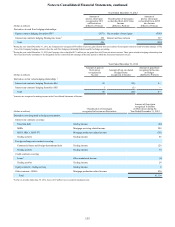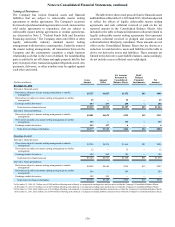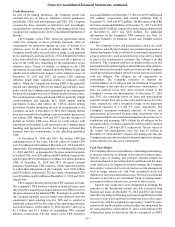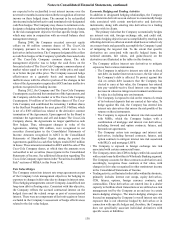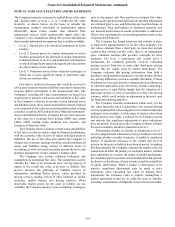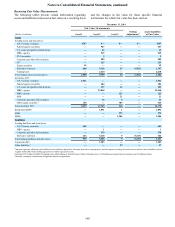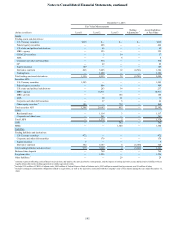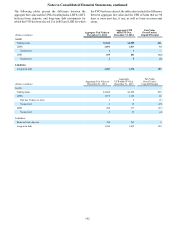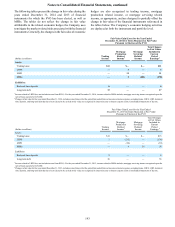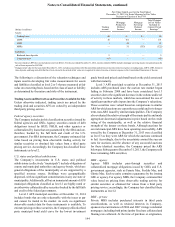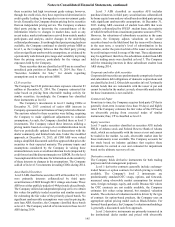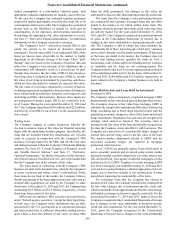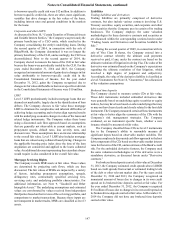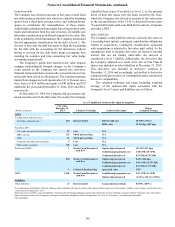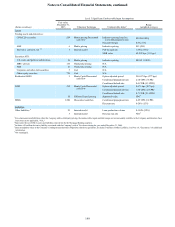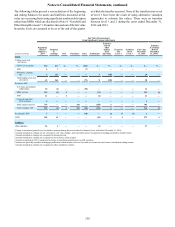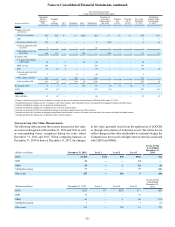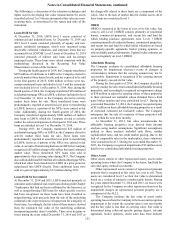SunTrust 2014 Annual Report Download - page 168
Download and view the complete annual report
Please find page 168 of the 2014 SunTrust annual report below. You can navigate through the pages in the report by either clicking on the pages listed below, or by using the keyword search tool below to find specific information within the annual report.Notes to Consolidated Financial Statements, continued
145
these securities had high investment grade ratings; however,
through the credit crisis, they have experienced deterioration in
credit quality leading to downgrades to non-investment grade
levels. Generally, the Company obtains pricing for its securities
from an independent pricing service. The Company evaluates
third party pricing to determine the reasonableness of the
information relative to changes in market data, such as any
recent trades, market information received from outside market
participants and analysts, and/or changes in the underlying
collateral performance. Even though third party pricing has been
available, the Company continued to classify private MBS as
level 3, as the Company believes that this third party pricing
relies on significant unobservable assumptions, as evidenced by
a persistently wide bid-ask price range and variability in pricing
from the pricing services, particularly for the vintage and
exposures held by the Company.
These securities that are classified as AFS are in a small net
unrealized gain position at December 31, 2014. See Note 5,
“Securities Available for Sale,” for details regarding
assumptions used to value private MBS.
CLO securities
The Company has CLO preference share exposure valued at $3
million at December 31, 2014. The Company estimated fair
value based on pricing from observable trading activity for
similar securities. Accordingly, the Company has classified
these instruments as level 2.
The Company’s investments in level 3 trading CDOs at
December 31, 2013 consisted of senior ARS interests in
Company-sponsored securitizations of trust preferred collateral.
The auctions related to these securities were failing, requiring
the Company to make significant adjustments to valuation
assumptions. As such, the Company classified these as level 3
investments. The Company valued these interests utilizing a
pricing matrix based on a range of overcollateralization levels
that was periodically updated based on discussions with the
dealer community and limited trade data. Under this modified
approach, at December 31, 2013, all CDO ARS were valued
using a simplified discounted cash flow approach that prices the
securities to their expected maturity. The primary inputs and
assumptions considered by the Company in valuing these
retained interests were overcollateralization levels (impacted by
credit losses) and the discount margin over LIBOR. See the level
3 assumptions table in this note for information on the sensitivity
of these interests to changes in the assumptions. The Company
sold all of its level 3 investments in trading CDOs during 2014.
Asset-Backed Securities
Level 2 ABS classified as securities AFS at December 31, 2013
were primarily interests collateralized by third party
securitizations of 2009 through 2011 vintage auto loans. These
ABS were either publicly traded or 144A privately placed bonds.
The Company utilized an independent pricing service to obtain
fair values for publicly traded securities and similar securities
for estimating the fair value of the privately placed bonds. No
significant unobservable assumptions were used in pricing the
auto loan ABS, therefore, the Company classified these bonds
as level 2. The Company sold all of its interests in these level 2
ABS during 2014.
Level 3 ABS classified as securities AFS includes
purchased interests in third party securitizations collateralized
by home equity loans and are valued based on third party pricing
with significant unobservable assumptions. At December 31,
2013 trading ARS consisted of student loan ABS that were
generally collateralized by FFELP student loans, the majority
of which benefited from a maximum guarantee amount of 97%.
However, for valuations of subordinate securities in the same
structure, the Company adjusts valuations on the senior
securities based on the likelihood that the issuer will refinance
in the near term, a security’s level of subordination in the
structure, and/or the perceived risk of the issuer as determined
by credit ratings or total leverage of the trust. These adjustments
may be significant; therefore, the subordinate student loan ARS
held as trading assets was classified as level 3. The Company
sold the remaining interests in these subordinate student loan
ARS during 2014.
Corporate and other debt securities
Corporate debt securities are predominantly comprised of senior
and subordinate debt obligations of domestic corporations and
are classified as level 2. Other debt securities in level 3 primarily
include bonds that are redeemable with the issuer at par and
cannot be traded in the market; as such, observable market data
for these instruments is not available.
Commercial Paper
From time to time, the Company acquires third party CP that is
generally short-term in nature (less than 30 days) and highly
rated. The Company estimates the fair value of this CP based
on observable pricing from executed trades of similar
instruments; thus, CP is classified as level 2.
Equity securities
Level 3 equity securities classified as securities AFS include
FHLB of Atlanta stock and Federal Reserve Bank of Atlanta
stock, which are redeemable with the issuer at cost and cannot
be traded in the market. As such, observable market data for
these instruments is not available. The Company accounts for
the stock based on industry guidance that requires these
investments be carried at cost and evaluated for impairment
based on the ultimate recovery of cost.
Derivative contracts
The Company holds derivative instruments for both trading
purposes and risk management purposes.
Level 1 derivative contracts generally include exchange-
traded futures or option contracts for which pricing is readily
available. The Company’s level 2 instruments are
predominantly standard OTC swaps, options, and forwards,
measured using observable market assumptions for interest
rates, foreign exchange, equity, and credit. Because fair values
for OTC contracts are not readily available, the Company
estimates fair values using internal, but standard, valuation
models. The selection of valuation models is driven by the type
of contract: for option-based products, the Company uses an
appropriate option pricing model such as Black-Scholes. For
forward-based products, the Company’s valuation methodology
is generally a discounted cash flow approach.
Level 2 derivative instruments are primarily transacted in
the institutional dealer market and priced with observable


